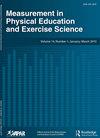青少年垂直跳跃力与骨骼健康结果相关:ROC分析和诊断性能
IF 1.9
4区 教育学
Q2 EDUCATION & EDUCATIONAL RESEARCH
Measurement in Physical Education and Exercise Science
Pub Date : 2021-12-09
DOI:10.1080/1091367X.2021.2013230
引用次数: 5
摘要
摘要使用健康青年(n=466,10-18岁)的样本,我们报告了垂直跳跃力(VJ power,W)在预测骨强度方面的预测效用。我们使用机械成像和骨强度指标,即高度调节的总骨矿物质含量减去头部(TBLH BMC,g),使用DXA测量VJ功率。生长曲线模型用于将VJ功率转换为年龄和性别特定的百分位数/Z分数。使用受试者-操作者特征曲线分析,即曲线下面积(AUC),以及基于VJ功率百分位数的理想组、边际组和低组的灵敏度(Se)和特异性(Sp),来检查相关性。TBLH BMC≤−2.0的VJ Power百分位数Z评分的AUC为0.84。边际组和低硒组的硒含量分别为71.4%和42.9%。边际组和低组的Sp分别为85.2%和95.1%。结果表明,使用VJ功率百分位数来评估骨强度是有用的。本文章由计算机程序翻译,如有差异,请以英文原文为准。
Vertical Jump Power Is Associated with Healthy Bone Outcomes in Youth: ROC Analyses and Diagnostic Performance
ABSTRACT Using a sample of healthy youth (n = 466, 10 to 18 yr), we report the predictive utility of vertical jump power (VJ Power, W) for predicting bone strength. We measured VJ Power using mechanography and an indicator of bone strength, i.e., height-adjusted total bone mineral content less head (TBLH BMC, g), using DXA. Growth curve models were used to convert VJ Power to age- and sex-specific percentiles/Z-scores. Associations were examined using receiver operator characteristic curve analysis, i.e., area-under-the-curve (AUC), as well as sensitivity (Se) and specificity (Sp) for Desirable, Marginal, and Low groups based on VJ Power percentiles. The AUC was 0.84 for TBLH BMC ≤ −2.0 Z-score from VJ Power percentiles. Se for Marginal and Low groups were 71.4% and 42.9%, respectively. Sp for Marginal and Low groups were 85.2% and 95.1%, respectively. The results suggest the utility of using VJ Power percentiles for assessing bone strength.
求助全文
通过发布文献求助,成功后即可免费获取论文全文。
去求助
来源期刊

Measurement in Physical Education and Exercise Science
Medicine-Orthopedics and Sports Medicine
CiteScore
4.20
自引率
33.30%
发文量
24
期刊介绍:
The scope of Measurement in Physical Education and Exercise Science (MPEES) covers original measurement research, special issues, and tutorials within six substantive disciplines of physical education and exercise science. Six of the seven sections of MPEES define the substantive disciplines within the purview of the original research to be published in the journal: Exercise Science, Physical Activity, Physical Education Pedagogy, Psychology, Research Methodology and Statistics, and Sport Management and Administration. The seventh section of MPEES, Tutorial and Teacher’s Toolbox, serves to provide an outlet for review and/or didactic manuscripts to be published in the journal. Special issues provide an avenue for a coherent set of manuscripts (e.g., four to five) to collectively focus in-depth on an important and timely measurement-related issue within the scope of MPEES. The primary aim of MPEES is to publish high-impact manuscripts, most of which will focus on original research, that fit within the scope of the journal.
 求助内容:
求助内容: 应助结果提醒方式:
应助结果提醒方式:


